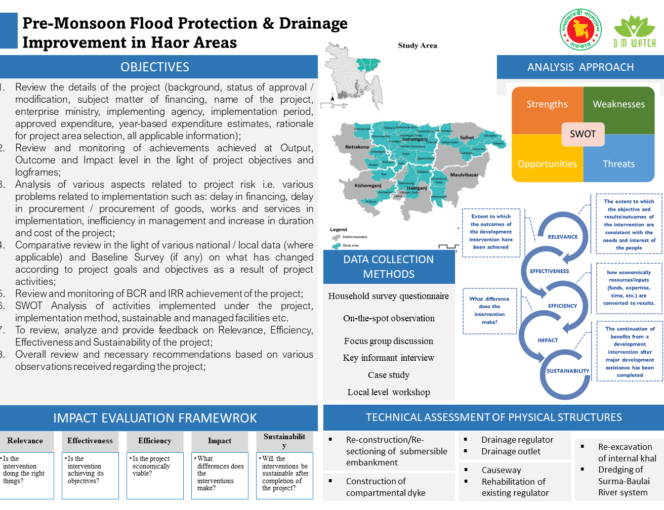

Impact Evaluation of the project titled “Pre-Monsoon Flood Protection and Drainage Improvement in Haor Areas (2nd Revised)”

“Pre-Monsoon Flood Protection and Drainage Improvement in Haor Areas (2nd Revised)” is a project ($82million) sponsored by Ministry of Water Resources and implemented by Bangladesh Water Development Board (BWDB) from July 2011 to June 2019, in 29 Upazila’s of 6 Districts (Sylhet, Sunamganj, Moulvi Bazar, Kishoreganj, Netrokona & Habiganj) of Haor regions of Bangladesh. The aims of the project were i) to ensure protection of Boro crop against pre-monsoon flash flood; ii) to increase conveyance capacity of major rivers in haor areas; iii) to improve capacity of internal drainage khals; and iv) to improve navigation in the North-eastern region.
Main activities of the project were i) Improvement of existing submersible embankment; ii) Construction of some new submersible embankment; iii) Construction of Drainage Regulators, Causeways, Drainage Outlets, Irrigation Inlets; iv) Re-excavation of Internal Khals; and v) Dredging of Surma-Boulai river system. To evaluate the impact of the project, the research team employed a mixed methodology (both quantitative and qualitative) and used KII, FGD, Physical observation, Case study, Local level workshop, and Secondary document review as study tools.
There were 480 household surveys, 35 KIIs, 6 FGDs, 20 Physical observations, 1 case study, 1 Local level workshop and 1 National level workshop to gather and analyze primary data for the impact evaluation. The study team assessed whether the activities were carried out in accordance with the approved DPP/RDPP, whether the project achieved its objectives, and if so, to what extent, and if not, why not. The study also evaluated the influence of the project on the agricultural, socioeconomic, financial, and environmental conditions of the study region. From data collection, analysis, and triangulation, the study team recognized the project’s significant Strength, Weakness, Opportunities, and Threats, and recommended to the IMED and Ministry of Water Resources which factors should be considered for future projects of a similar nature.
© 2023 DM WATCH LIMITED. All Rights Reserved
